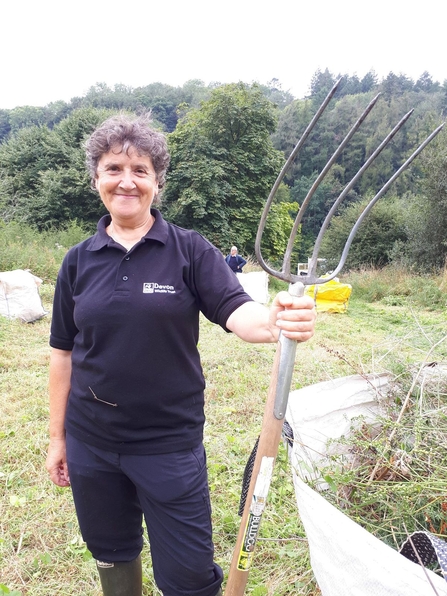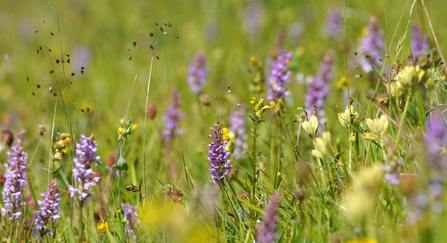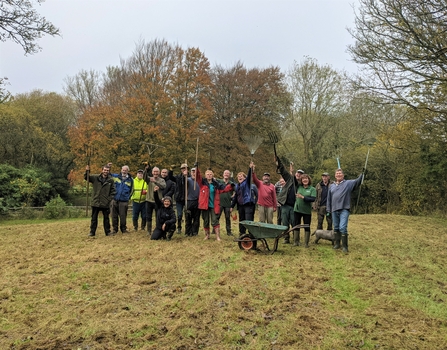We are working and living within this context of environmental and ecological collapse, with species decline and poor habitat quality. I see my role as being someone optimistic, giving people confidence that the changes they make, could make a real difference.
Interview with Lynne Kenderdine
They spoke about the hidden aspects of her role, her time as a volunteer, and how important it is to find common ground when making positive changes for wildlife.
Rose Mason
How would you summarise your role and what you do at Devon Wildlife Trust?
Lynne Kenderdine
My job title is Land Management Advisory Officer, and I have a bit of a different role from other advisors within the Trust who are mainly working with farmers.
On the Avon Valley Project, which is the project I lead on, we set out to work with anybody and everybody who owns or manages land. They don't have to be a farmer. Within that I'm able to offer free habitat management advice, site visits covering the whole range of farmland habitats. I meet with landowners and assess their land from a biodiversity point of view. whether that's grassland habitats, wildflower meadows, hedgerows, ponds, or orchards. If it's farmland, there could be some arable land and arable margins. So, all the time, I’m assessing it from a biodiversity perspective, what’s there and how it could be enhanced.
What’s really important for me, and I think all advisors, is to listen to what landowners want and what farmers want. What people need from their land and what their aspirations are.
That could be a 100-acre dairy farm which is very economically driven, looking at their gross margins and profit and loss accounts, where the land has got to earn a living. Or it could be people who have maybe bought a couple of acres and want to do something good for wildlife.
A big part of my job is to inspire and enthuse people, I think that’s one of those hidden aspects of the job. We are working and living within this context of environmental and ecological collapse, with species decline and poor habitat quality. I see my role as being someone optimistic, giving people confidence that the changes they make, could make a real difference.
Within the Avon Valley Project, as well as offering habitat management advice, we have an active wildflower meadow restoration element. If people say they’d like to create or restore a wildflower meadow, I look at their existing habitat and say to them, don’t spend a fortune on seed, work with what you’ve got, get to know your land and enjoy it and you will start to see the changes.
We want them to get out in their fields and notice. They might not get the plants coming in right away, but by making changes to management they certainly get structural diversity, something more varied in a relatively short space of time. I guess part of my role, through those early stages when it doesn’t look like there’s lots of change, is to keep people engaged and enthused.
We help people by donating wildflower seed harvested from yellow-rattle rich meadows. We also sometimes offer volunteer support. I can arrange volunteer groups to go out and help cut back scrub or help with meadow preparation, cutting and raking, that kind of thing.
Over the past three years, we've planted 6000 trees in the catchment. I've had windfall trees from the Woodland Trust via Working Wetlands. One year I had 1000 trees, the next year I had 2000, the next year I had 3000.
I've got another 3000, fingers crossed, coming this autumn. Through my visits, I'm asking people if they'd like to plant a little bit of a woodland or plant a new hedge or a shelter belt. I’m able to direct those trees to them complete with tree guards and everything needed. To be delivering habitat change like this is really exciting.

Lynne Kenderdine at the Longmarsh Hay Cut
Rose Mason
I think often people feel really paralysed by the climate crisis. In the scale of it, you feel as though you must change everything about the way you live your life, or you feel that what you do makes no difference at all. It seems what you do is offer people concrete actions they can take to change the land around them in a positive way. It is quite empowering to give people information and knowledge which enables them to make those changes and see the difference.
Lynne Kenderdine
Yes, you're right. A few people have said to me, maybe they don’t own land, but once they know that this is going on, they see it around them. They see it as something really positive. The fact that it is happening and the fact that we're getting more habitat connectivity, that we're reinforcing wildlife corridors that exist already and creating new ones.
I feel fortunate because I've been allowed to run and help shape the Avon Valley Project. Certainly, in South Devon, communities have looked at what we've done in the Avon and said they want to do something similar. We’ve encouraged groups like the Yealm Estuary to Moor partnership, Wild About the Erme River, Wild About Loddiswell, and Avon River Champions. I think we've been part of planting a seed for those groups, who will hopefully take what we've established with the Avon Valley Project a step further and keep the momentum going.
Each year I make about 110 or 120 site visits. I connect with, if you drill that down to individuals, over 300 people a year. They're all receiving the same kind of can-do messages.
I see myself, thinking football at the moment, as a kind of dynamic midfielder. I might be able to put someone in touch with somebody else, which means that they can get the work done or get the help they need.
Each year we hold a Meadow Makers’ barbecue, held at a different landowners’ meadow every time. There people can meet groups like Cows in Clover who are conservation graziers with a herd of cattle that go around grazing purely for conservation goals.
The relationship aspect is something that's hugely important to me. While grants are important, I hate to hear things drilled down to ‘GX34’ or you talk about a wildflower meadow and it's a ‘GRH6’. That's great, because it's a code that relates to a scheme.
But it's not the story of that beautiful, buzzing, wildflower meadow. The meadow full of tiny wildflowers which are giving homes to butterflies and moths and the cinnabar caterpillars that you can see on the ragwort stems at the moment. It’s not the story of the brown hare or the deer you see ranging through, or the sound of the grasshoppers and crickets.
If it all just gets drilled down to a code, it diminishes the quality of the habitat for me.
Rose Mason
I suppose that's not what connects with people either. It's got its use, but I think when you're working with people what is meaningful for them is seeing that wildlife, seeing the change and having that story.
Lynne Kenderdine
I always talk in terms of the habitat first and then the grant scheme is the option afterwards. Things might have changed, they might just want to know what the code is, what money they're going to get, with habitat as a secondary concern. But that's not the way that that I work.
Rose Mason
It seems like there's not a typical day at work for you. Because you're working with such a wide range of landowners, I imagine it requires a different approach every time. But is there a typical workday for you?
Lynne Kenderdine
There are typical patterns within the seasons. Over this summer period, from end of April right through to July and August, it's about meadow monitoring. Going out and seeing if the yellow-rattle seed has taken, how things are varying from year to year, whether a site has been grazed or cut.
Now we’re in a drought situation with the grasses dominating, how can I help a landowner with future management? What can I advise? Who can I put them in touch with? Essentially, it’s eyes and feet on the ground, assessing whether we're starting to get more wildflowers and beginning to shift the balance on sites.
Then there is seed harvesting. Normally that’s a very short window, because then you've got to add the weather into that. If it's wet, we can't harvest. This year, the yellow-rattle seeded early, so we were harvesting in June rather than mid-July.
Now I'm thinking about if we can harvest later-flowering seed; knapweed, wild carrots, and vetches. Have we got any sites we could harvest from? If we are going to do that, then we need to be doing it through August and September.
Then we go into the autumn and meadow preparation for seeding. You can't seed into a sward that’s really long, so you need the landowners to have cut or grazed before you can put the seed on. We've got about 30 sites where we deliver seed before the cutoff point of the solstice in December.
Then we've got tree planting. If I'm getting some free trees logistically, have I got enough time and space to get the trees from Cookworthy? When are they having them delivered?
What's lovely is that people come back.
You might not see them all the time, but three years later, they'll e-mail again wanting some more advice. Or perhaps personal circumstances have meant that they've not been able to do what I advised, or they've carried out the recommendations and are ready to go a step further.
I'm working with a farm at Torbryan in Teignbridge, where I last visited about 10 years ago. It's a lovely bit of limestone grassland, but it's not been managed properly and is very grass dominated. I surveyed that on Friday and I've just set a date to sit down with the family, put my findings on the table, and listen to what they want from their land.
Limestone grassland isn’t that common in Devon, so I’ve made them aware they've got some special limestone grassland species.
They’ve more than likely got dormice; they've got fantastic wasp spiders which I was amazed to see. They've got swallows, they've got skylarks which they thought they'd lost. They've got a nesting barn owl and loads of dragonflies on their lake.
So, it’s about looking at how they can manage the land a little bit better for those key species.
That's the several pots simmering with various landowners. It's never boring. I'm never sitting twiddling my thumbs thinking what am I going to do today?

Orchids in a meadow © Jim Higham
Rose Mason
It sounds like it's quite a lot of having to go between different people and different groups and coordinate them, a lot of logistics and people involved.
Lynne Kenderdine
Yes, it is a lot. When we do our end of year reports I'm always amazed when I add up how many people that I've seen. It’s a really forward-facing role with those one-to-one interactions and the opportunity to enable them to really make a difference.
They're the people who do the work; at the end of the day their decisions really matter.
I like to think that I do it in a way which is enabling and empowering, rather than coming in with an approach which is you've really got to do this because wildlife is declining at an alarming rate and it's down to you. I might say that, but I don't say it like that.
I say, you have got the opportunity to make a real difference. This is how your little bit of land fits into that bigger picture like a massive jigsaw.
I show them a scruffy paper map I've got which outlines all the holdings I visit, and I explain to them where they fit into that and how their bit of land relates to their neighbours. It could be that they’re near nature reserves and if they allowed a hedgerow to grow up or thought about planting a few more trees, it would link to a neighbouring woodland. It could be digging a pond. Things to create more stepping stones for the widest range of species possible across our landscape.
Some people will say they want a barn owl and want to put up a barn owl nest box, but they won’t have enough grassland or habitat for small mammals. I will file that away and then as I’m walking around with them, I will ask if they could let areas of grassland grow up to create the feeding source for the owls. Then they may have a chance of seeing them. That kind of thing.
Rose Mason
I suppose a lot of people don't think about how it's all linked. People think of their land as this isolated thing, and what they do to their land only effects their land, rather than seeing it as connected to all these other places with all these animals which will pass through.
Lynne Kenderdine
I have a different type of conversation with someone who's a commercial farmer, but certainly with non-farming landowners, I will suggest trying to see things from a bee's eye point of view, a brown hare’s point of view, or a butterfly's point of view. People will say they want to keep bees but will have very few pollinating plants on their land, so there’s no habitat for them. They’ll need to get more wildflowers, so where can they do that?
The big challenge is still the tidy mind.
People like to see everything neat. So, I’ll try and be creative. If I'm working with somebody who wants to cut the grass and have it short and neat, I will suggest perhaps mowing paths through an area, or letting areas of grassland grow up, maybe then just cutting some nice wavy edged paths through.
I have my wish list. At the very top I'd like everybody to be letting their hedges grow up a bit more, to be creating a nice little pond, to have wild areas. I mentally work down from that and focus on getting whatever gains for wildlife I can from whatever site that I work with. I think the advantage of having been around for a long time is that people come back to me years later and I get to visit those sites from 10 years ago and actually see the changes that they've made. And that's really heartening. It's a really, really satisfying role. I've never been bored with it.
My role is all about people, and having the help of volunteers has been amazing.
I'm able to get the support of the South Devon and Dartmoor Volunteer group via the Nature Reserves team. Whether that is Himalayan balsam pulling, tree planting, fencing work, meadow work, green hay seeding, or planting a new hedge in the pouring rain.
The volunteers have made so many things possible.
Those days have been some of the most enjoyable, being out with that group and seeing their willingness to get stuck in, seeing what they achieve at the end of the day.
It generates goodwill. I was talking with a farmer for ages about creating a new hedge, so it could link up to isolated woodlands. I said if you get the grant, I’ll see if I can get a volunteer group to do the planting.
He got a Woodland Trust grant and built a bank, then I got the volunteer group, and we planted it. That farmer has gone on to host events for us and speak well of us to other farmers. If somebody has a good experience with something, they'll share that.
I think that would be my message. Whether people are mature students or more mature people wanting a change of career direction, or graduates looking to get their first experience, you should volunteer.
Rose Mason
You started off as a volunteer at Devon Wildlife Trust, what was that like?
Lynne Kenderdine
I started my working career as a secretary and in my early 30s I wanted to change the direction of my career. At that time, I was working as an admin officer in the Walsall social services Child Protection Unit. I used to skim the Guardian on a Friday and see these countryside job officer posts, and I used to think I'm going to have one of those.
Initially, I did six weeks with the Nature Reserve team. That involved sitting in a cold Land Rover in the snow at Rackenford and Knowstone, waiting to go out in the snow and thinking, surely we won't be cutting any scrub today, but surely, we were!
We went on Chudley Knighton Heath, we went on the culm sites, we went to Rackenford and Knowstone, we went swaling, we went to Wolborough Fen. I got the experience, and I got an idea of what these habitats were. Because I'd had some paid work on the environmentally sensitive areas, I got a six-month opportunity with the then Wildlife Sites Officer. I worked alongside her to deliver countryside stewardship agreements and I absolutely loved it.
I love working with people. I love getting out on a farm. I love the marrying of the farming and the conservation. That was exactly what I wanted to do.
That voluntary placement was the building bricks of my career, and looking back now, I'm so glad that it worked out as it did. If someone had said to me, when I was sitting bored in that office and wondering what I was going to do with my life, that in 30 years I could have the opportunity to influence landowners, to walk on private land and experience amazing wildlife encounters, I would have been amazed.
That opportunity to influence positive habitat change has been amazing. I'm really glad that I was able to set up that voluntary placement with DWT.
I learned so much from the great wealth of expertise within the Wildlife Trust. The people that I worked with when I first joined were so willing to take the time to explain what they were doing and why. I think that shadowing people in the field was the most important thing, listening to how the other advisors were with people, and watching the response that they got. It was just great to learn off them.

The Avon Valley Project 10 year Anniversary
Rose Mason
I think sometimes people feel like they must have that purely conservation background to join in. Whereas you can join in and learn as you go. People are very willing to share their knowledge.
Lynne Kenderdine
All you've got to do is invite people to show an interest and invite them to share what's there on the land or what they see.
I remember visiting some farmers in in my early days and they'd have their heads down. There wouldn't be any eye contact, and they'd say very little. I would say all the things that I needed to say, and I'd be sitting there thinking, maybe I'll wrap this up. Then, I'd look up and there'd be pictures of the farm. So, I'd just say, has your family been here a long time? That would be it. Three hours later, I'd be leaving with so much more than I ever thought I’d get.
But you got to try and find that common ground; ask how things are from their point of view.
Rose Mason
Is there any aspect of what you do that you think people wouldn't know about? Or something you do which you're proud of and perhaps isn't at the forefront of what people know about your work?
Lynne Kenderdine
When you say you're an advisor, I think it's very easy to say, I advise on this, this, and this and offer free of charge habitat assessments, and that's it. But then somebody emails and says Oh, Lynne, look what I've seen on my land.
It is the fact that they're noticing, they're noticing they have got a green woodpecker in their garden, they're connecting with the joy of having these encounters. It is the fact that they’re more aware of what nature they've got, and that I'm the person, we're the organisation, that they'll share that with. That's what I feel proud of in those moments.
This doesn't get reported in the figures. The numbers are the numbers: I've made 100 visits this year, I've seen 300 people. What that doesn't tell you is the story and the quality of the encounter.
You can speak to a room of 100 people, but you only need one of those people to go out and do something that makes a difference, or to have taken nature a little bit closer to their hearts.
It's a bit unquantifiable, but those are the things that matter the most.
Rose Mason
Was there anything else that you wanted to highlight or talk about or is there any aspect of a project that's coming up that you're excited about?
Lynne Kenderdine
There are so many people, so many landowners who want to do good things for nature. Helping those people and seeing those changes is very exciting. There should be more people working out there to keep the momentum and I think that is happening and that is coming.
Something I have come to accept, on a landscape scale, is that change is very transient. What might be going in a positive direction this year could change. The landowner could sell up, or get the cows on too early, or over-graze it with sheep, and you've lost it. But if you've got enough people making those changes over a wide area, then nature can hold fast.
I see it like a web, like connective tissue.
We are linking the Woodland Trust sites in the Avon Valley to Andrews Wood, to Dartmoor. We've got our hubs, but we need to make sure that we've got more of them and that the connective tissue between them is stronger. We are working within a farming environment that's very prone to change, prone to economic forces. So, if we have non-farming landowners too, if we have enough people taking action with their gardens or garden residential areas, that's got to be a good thing.

